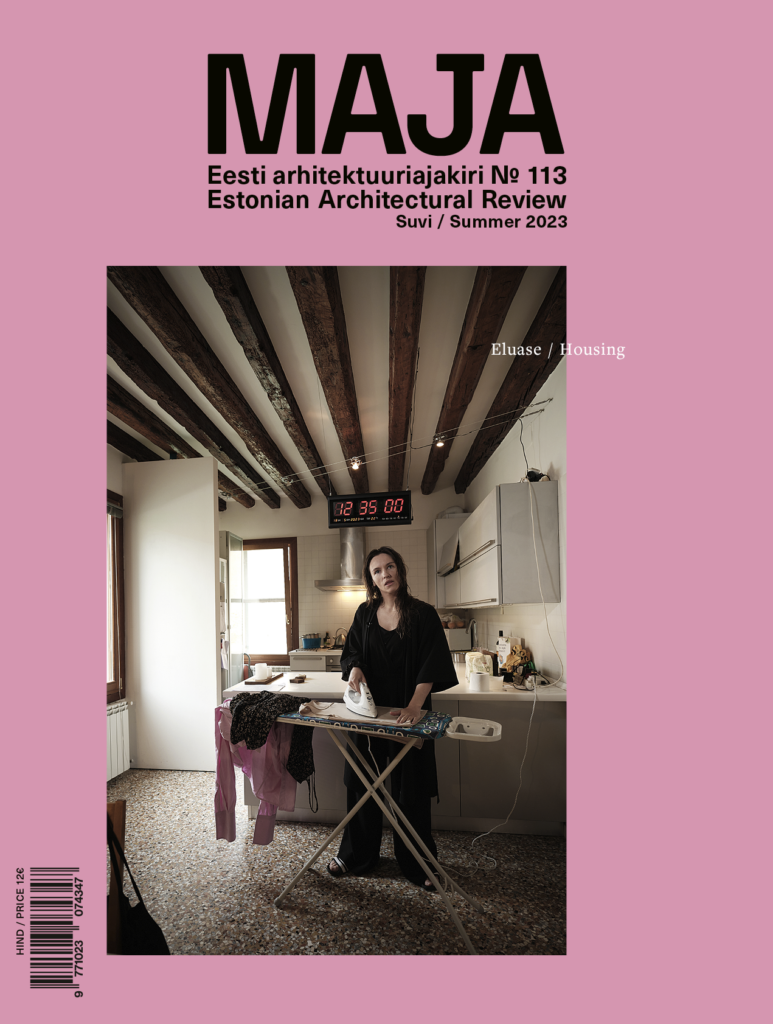OUTSET
Hot Bath and Cold Deal: Living space’s two faces
Mari Möldre
ESSAY
Estonian Housing Policy on the Threshold of a Relaunch
Veronika Valk-Siska
REVISIT
A Residential Quarter Like a Hedgehog
Tulbi-Veeriku, Pluss Architects, 2007
Elo Kiivet
ESSAY
On Housing and the Public Sector’s Responsibility in a Society with a Free Market Fetish
Hannes Aava
RESEARCH
The Marketised Domestic Interior. A Feminist critique
Mette Johanne Hübschmann
ESSAY
Area-based renovation of residential buildings
Lauri Lihtmaa, Murel Truu
Architecture in the Renovation Marathon. The race of energy efficiency, modernist heritage and spatial integrity
Diana Drobot, Päär-Joonap Keedus
ESSAY, CASE STUDIES
Community-Led Housing
Eneli Kleemann, Helena Rummo
IN PRACTICE
A Cooperatively Developed Rooftop in Vilnius
Mantas Peteraitis, Laura Linsi
Housing
A home, if we have one and if it satisfies our needs, is a private matter. But if we cannot afford its upkeep costs or it does not meet our requirements, or we have no housing at all, it suddenly becomes political. The Universal Declaration of Human Rights already adopted by the UN in 1948 declares the right to adequate housing as a fundamental right. However, housing is still not available to everyone, not even in prosperous countries. In Europe, there is no country whose government does not take at least some measures to regulate its housing market. The goal of such government policies in general should be, as Hannes Aava puts it, ’to keep cities socially diverse, lively, and affordable for as many sections of society as possible’. (p. 42). This intervention matters, since the domination of business interests could turn quality housing into a luxury good. In this issue, Estonia’s approach to and development of the housing sector is discussed by Veronika Valk-Siska who is the Head of Housing Policy at the Ministry of Climate (p. 18).
Being a home and being a property are the different yet intersecting dimensions of the same living space. Their relationship, often fraught with tension and caught between ’a hot bath and a cold deal’, is examined by Mari Möldre (p. 6), one of the curators of ’Home Stage’, the Estonian Pavilion at this year’s Venice Architecture Biennale. Elo Kiivet revisits Tulbi-Veeriku quarter in Tartu where the friction between these two aforementioned dimensions has given rise to one of the most praised new neighbourhoods of the early noughties in Estonia (p. 32). The Danish architect Mette Hübschmann analyses the domestic interiors of speculative housing development from a feminist standpoint (p. 50).
Also in Estonia, speculative development and construction typical of contemporary housing could be balanced by shared ownership, community-led and community-managed housing models that set the use value above exchange value. Helena Rummo and Eneli Kleemann who explored cooperative housing in their Master theses, share with us relevant examples of not-for-profit housing development in Europe (p. 82). We will then look to Vilnius where the architect Mantas Peteraitis led the cooperative development of a Soviet Era industrial building’s attic space, which became home for 16 households (p. 96).
Paraphrasing Veronika Valk-Siska: a good living environment goes beyond the functional, ecological or economical, it also responds to the residents’ social, cultural and psychological needs. And that is why the architect who bridges the aims and wishes of the experts and institutions, clients and residents, is the key to shaping truly high quality housing.
Laura Linsi





